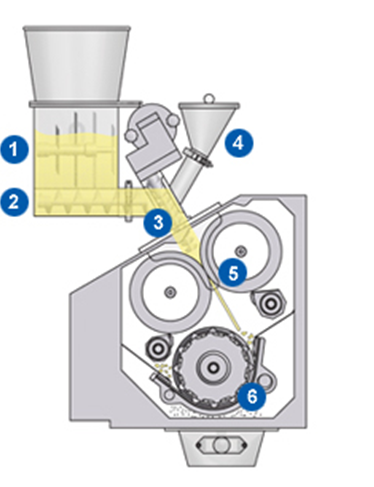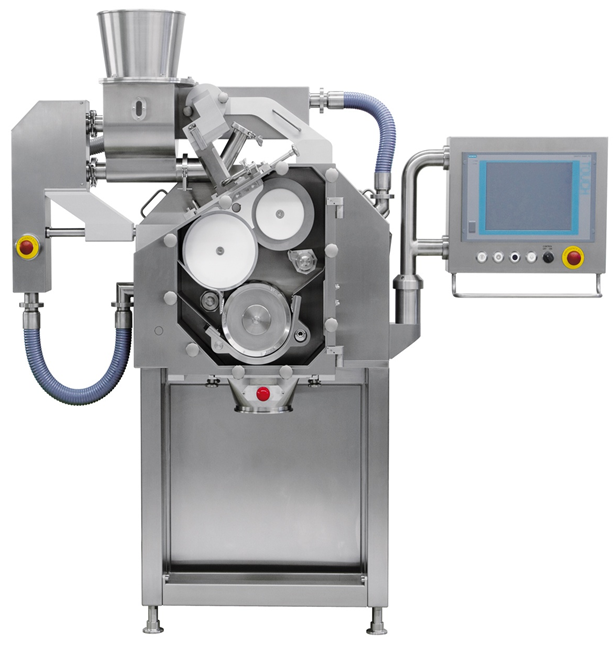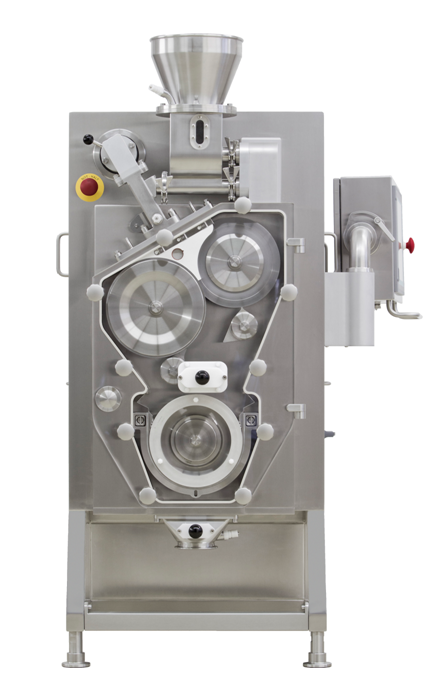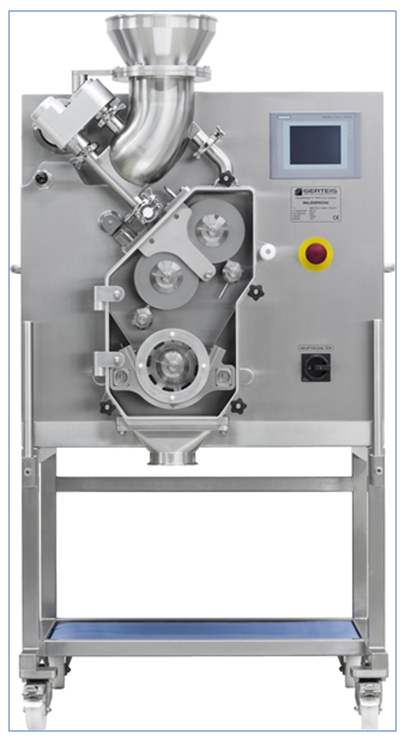By Gerteis Maschinen…
Advanced pharma roller compaction concepts from Gerteis®
More than three decades of constant development and innovation has made Gerteis® from Switzerland the internationally respected expert force in pharmaceutical granulation by roller compaction.
The versatility of renowned Gerteis® pharmaceutical roller compactors, including MACRO-PACTOR®, MINI-PACTOR® and POLYGRAN®, support compaction of all kinds of pharmaceutical powders. Also products with challenging characteristics are possible.
Pharma roller compaction concept
In the pharmaceutical granulation process, powder particles are made to adhere to each other, resulting in pharmaceutical granules as larger, multi-particle entities.
Dry granulation roller compaction is an agglomeration process relying on high pressure to bond powder particles together to form the so called ribbon, also known as briquettes or flakes. The effectiveness of this powder agglomeration bonding is affected by the compressibility, deformation and fragmentation characteristics of the basic materials.
In contrast to wet granulation, dry granulation is a continuous process. This results in various economic advantages, not least increased throughput with dry powder granulation systems reaching up to 400 kilograms per hour, along with lower investment for clean room space, coupled with lower energy demand and reduced ecological footprint and maintenance costs.
Density, flowability and compressibility
Flowability and compressibility are both important factors in determining how powders will behave under roller compaction, and both variables are to large extent product of densities, expressed both as poured density and tapped bulk density (tap density).
Poured density describes the ratio between ‘loose’ mass of particles and the volume, while tap density is defined as the ‘packed’ density of the same quantity of powder blend when subjected to defined external force. Tapped density is therefore a highly useful measurement of the minimum packed volume achievable for any quantity of powder, which will depend on particle shape, size, PSD (particle size distribution), and surface characteristics, as well as the agglomerated state (cohesiveness) of the powder. Thus tap density of a material can be used to predict both its flow properties and its compressibility, which are the two key factors in predicting how materials will behave in roller compaction and tableting and ultimate product qualities, such as tablet strength, porosity and dissolution characteristics, as well as capsule or sachet filling performance.
The poured density and tap density of powdered materials form the basis for the Carr Index (or Carr’s Compressibility Index) , which uses the relationship between freely settled bulk density and tapped density to quantify the compressibility of a powder and thus predict its flowability. Carr Index results lower than 15 indicate good flowability while results greater than 25 indicate poor flowing powders.
Similarly, the Hausner Ratio between tapped density to poured density is an indicator of interparticle friction, again with higher results indicating poor flowability and with <1.25 regarded as a minimum standard for free-flowing powders.
Basic pharma tablet compaction process
The overall tableting compaction process consists of six basic steps when performed on tablet press only:
- Prepare formulation ingredients: appropriate quantities of formulation ingredients (active ingredients and excipients) are weighed and dispensed, with preliminary particle size reduction carried out where necessary.
- Pre-mixing: Weighed and dispensed ingredients are mixed into a uniform powder blend, with some lubricants added where required to enhance powder flow during slugging and prevent sticking in the die during precompression.
- Precompression into slugs: During ‘slugging’, mixed ingredients are precompressed into flat large tablets or pallets termed slugs that are typically 25 mm in diameter and up to 15 mm in thickness. Note that slugs can exhibit considerable variations in mechanical strength, which why slugging is falling out of favor as a separate dry granulation step. In the Gerteis® method, precompression is built into the roller compaction process itself.
- Milling/sieving: Formed slugs are broken up into smaller pieces using a hammer or other mill, with milled slugs screened to produce uniform granules.
- Add disintegrant/lubricant: After screening, the remaining lubricant and other extragranular excipients such as disintegrant, glidant etc., are added to the granulation and mixed gently to achieve a uniform blend.
- Final tablet compression: Mixed granules are compressed into tablets using either single or rotary tablet press fitted with appropriate punches and dies, and coated, where required.
Gerteis® roller compaction
A Gerteis® Roller compactor generally consists of three major sub-modules that combine powder feeding, compaction and milling into one machine. The roller compactor therefore comprises:
- Feeding system to convey powder to the compaction area between the rolls
- Compaction unit where force is applied between two counter rotating rolls to compact powder to a ribbon.
- Size reduction unit to mill the ribbons to desired uniform particle size distribution.
The Gerteis® compactor compresses the powder between two rolls by applying a force, which is the most important parameter in the dry granulation machine process. The applied force is expressed in kN/cm, being the force per cm roll width. At a given force, depending on the amount of powder conveyed to the rolls, the powder will be compacted to a defined ribbon thickness.
A precise process control with respect to both force and gap is essential to obtain even granular properties from a homogenous ribbon. Unlike fixed gap roller compactors, Gerteis® well proven gap control system detects smallest deviations in powder feeding and counteracts immediately to stabilize gap aiming to minimize property fluctuations in the granules.
The Gerteis® Process Analytical Tool (PAT) enables its roller compactors to control and measure all product quality relevant parameters, including force, gap and roll speed on-line. This is essential to fulfill all requirements of the pharmaceutical industry for a well-controlled and documented manufacturing process.
Additionally Gerteis® machines are fitted with control systems that allow equal granule properties despite batch to batch variations during manufacturing.
Resources
Click on The Gerteis Concept to learn more on dry granulation roller compaction principles.
Click on Influence of Roller Compactor Process Parameters on Granule properties to see highlights of joint study by Gerteis® and Freeman Technology Ltd.





















